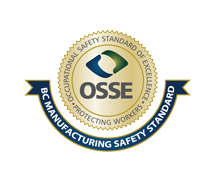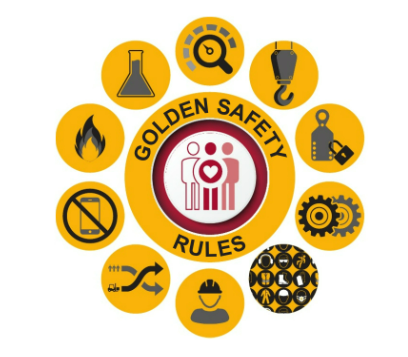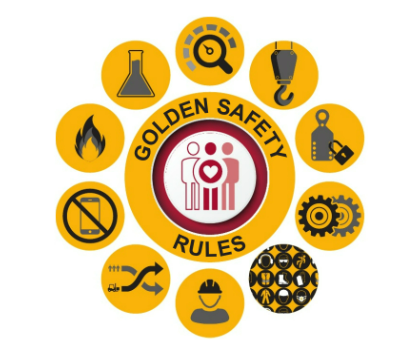Title Page
-
Conducted on
-
Prepared by
-
Location
-
Signature
Points of operation
- Points of Operation - Primary machine safeguarding
-
Is there a guard or safety device provided for each point of operation of the machine?
-
Are the guards complete? (Do the guards allow the operator's hands, arms, or other body parts to make contact with hazardous machine parts?)
-
Are the guards effective? (Is there evidence that the guards have been tampered with or bypassed to make them ineffective?)
-
Are the guards firmly secured and not easily removed? Specific tools must be used to remove the guards
Secondary machine safeguarding
-
Is there a guard or safety device provided for each access point of the machine?
-
Are the guards complete? (Do the guards allow the operator's hands, arms, or other body parts to make contact with hazardous machine parts?)
-
Are the guards effective? (Is there evidence that the guards have been tampered with or bypassed to make them ineffective?)
-
Are the guards firmly secured and not easily removed? Specific tools must be used to remove the guards
Operator Controls
Operator Controls
-
Are starting / stopping controls within easy reach of the operator?
-
If there is more than one operator station, are separate controls so located that operators can see the entire operation?
-
Do these controls only function only when all protection devices are correctly set?
-
Are controls, including foot controls, guarded against accidental activation?
-
Are controls labeled to identify their function?
-
Are controls similar in type and arrangement to other similar machines in the plant?
-
Are emergency stop controls easily accessible? About one every 2 mt
-
Are emergency stop controls clearly identified?
-
Is the machine wired so that it must be manually restarted if power is interrupted and then reapplied? Reset required
General Safeguarding Requirements
General Safeguarding Requirements
-
Are controls that require two handed activation wired to include the following:<br>- Concurrent use of both hands?<br>- Anti-Repeat?<br>- Anti-Hold Down?
-
Can the machine be locked out at each power source?
-
If applicable, has a separate circuit and lockout capability been provided for auxiliary equipment (i.e. Hot melt pot) on the machine which may require power during short duration maintenance shut downs?
-
If equipment is provided with a jog function, is it designed so that it cannot be used to operate the machine continuously (instead of inching)?
-
If access is normally required to a danger zone of the machine, (such as for clearing jams) are interlocked barrier guards or similar system used to prevent access while the machine is in operation?
-
If the machine has a thread speed mode, do safety devices (e.g. interlocks, photocells, etc) continue to function in this mode?
-
Do interlocked barriers incorporate a braking system, or zero motion detection system, when coast down time is a concern?
-
Are the guards designed so that they will not create hazards such as shear or pinch points or sharp edges?
-
Can adjustments be made without removing or opening any guards?
-
Can the machine be lubricated without opening or removing any guards?
-
Is there sufficient room for maintenance and repair?
-
Is there adequate lighting in general at the points of operation?
-
Is there adequate supervision to ensure that employees are following safe machine operating procedures?
-
Are safety procedures in place for minor intervention activities (such as jam clearing, cleaning, adjustments) and start up?
-
Are employees trained on all applicable safety procedures relating to machine operation?
-
Is all machinery and equipment kept clean and properly maintained?
-
If special hand tools are used for placing and removing material, do they protect the operator's hands?
-
Are provisions made to prevent machines from automatically starting when power is restored after a power failure or shut down?
Other requirements
Protection against specific hazards
-
Can the work equipment catch fire or overheat?
-
Can items be ejected form the equipment?
-
Are suitable precautions in place to prevent inadvertent contact with very cold parts?
-
Are suitable precautions in place to prevent inadvertent contact with hot parts
-
Is the lighting in the area suitable to allow for the operations being undertaken?
-
Is the equipment provided with suitable markings to warn of hazards present?<br>(e.g. radiation etc.)
-
Is the equipment fitted with suitable warning devices and notices for operational risks?<br>(e.g. alarms etc.)
-
Is the operator dressed safely for the job? (i.e. No loose fitting clothing or jewelry)?
Inspection
-
Are regular inspections undertaken? Safety devices must the tested every week (at least)
-
Are functional tests undertaken of safety devices as part of an inspection?
-
Are records of the above inspections and tests kept?
-
Do competent persons conduct inspections?
Maintenance
-
Is the machine included in the preventive maintenance plan?
-
Is a record of maintenance kept?
Information and Instructions
-
Are written instructions available for the safe use of the equipment?
-
Are written instructions available to maintenance and other similar personnel?
-
Have specific risks been identified in connection with the equipment? (setting up etc.)
-
Are written instruction available to guarantee that the equipment can be safely isolated from all sources of energy
Training
-
Is training undertaken of persons who are required to operate the equipment?
-
Is the training updated to accommodate changes in working methods and modifications?
-
Has training been provided to cover the use of any specialist equipment required?
Risk assessemnts
-
Is there a noise Risk?
-
noise measurements done every 3 years
-
Is there a vibration Risk?
-
vibration measurements done every 3 years
-
Is there an ergonomics Risk (manual handling, repetitive movements, workstation,...)?
-
an Ergo risk assessment has been conducted
-
Is there a chemical Risk associated to the use of the machine?
-
chemical management risk assessment has been conducted
Reference
- OTHER OBSERVATION
-
Add your observations here













